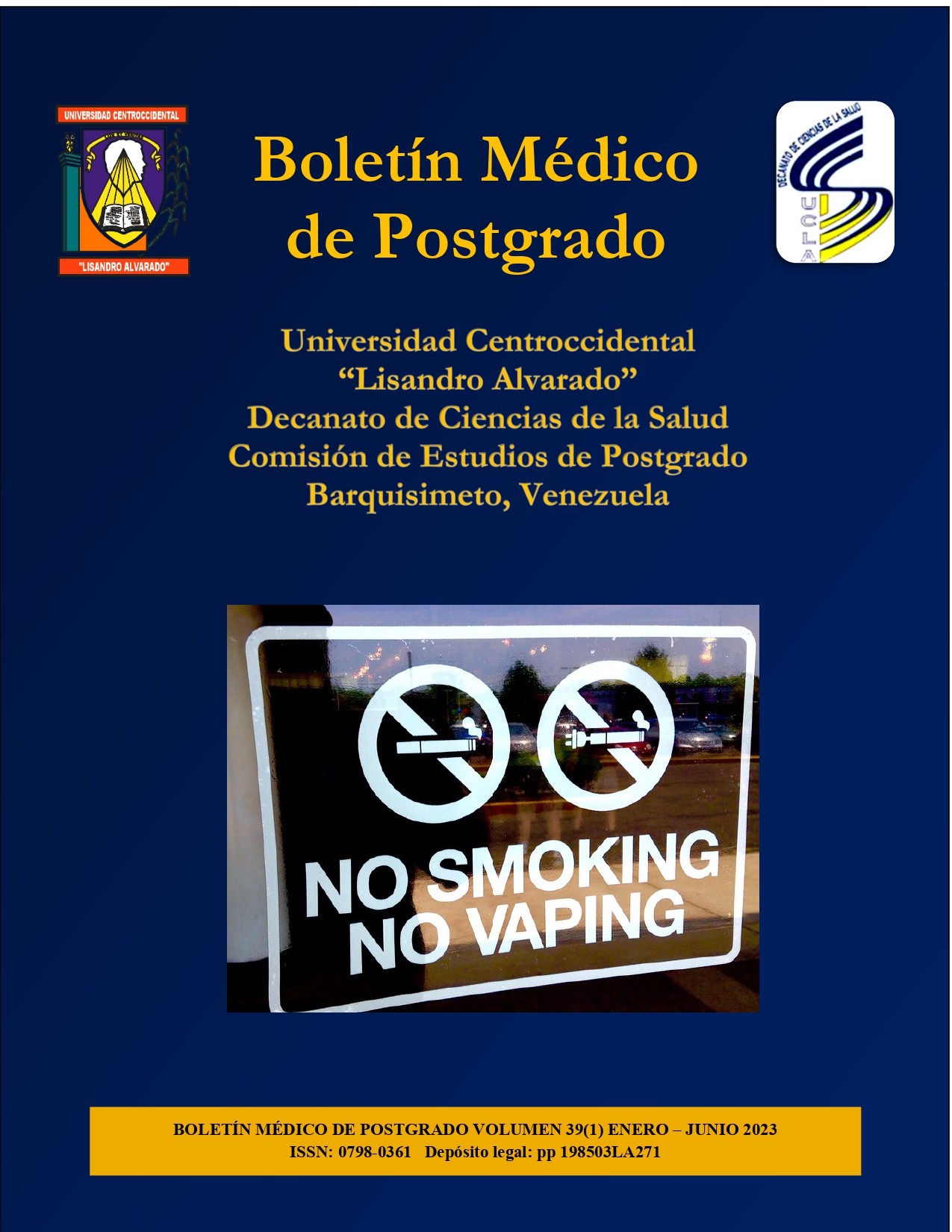Usefulness of regional blocks for intubation in awake patients with difficult airway subject to general anesthesia
Keywords:
anesthesia, airway management, intubation, nerve block, oxygenAbstract
In order to determine the usefulness of regional blocks for intubation in awake patients with difficult airway under general anesthesia who were admitted to the Hospital Central Universitario Dr. Antonio María Pineda during the period May-July 2021, a descriptive cross-sectional study was conducted, selecting a total of 32 patients which had an average age of 41.16 ± 10 years, with male sex predominance (62.5%), physical status ASA I (46.88%) and II (53.12%) and with difficult airway criteria. The main surgical pathologies were supraglottic/glottic tumor (18.75%), thyroid goiter, acute cholecystitis and clavicle fracture (15.63%, respectively). Oxygen saturation remained similar during the procedure, with no statistically significant differences, and capnography was normal after intubation. Regional blocks were performed at the level of the glossopharyngeal, superior laryngeal and transtracheal nerves, obtaining that 87.5% were effective. The average intubation time was 3.75 ± 2.39 minutes and 71.88% were successful at the first attempt. Only 3.12% of complications were reported during the procedure, mainly pain at the block site. These results show that regional blocks are a safe alternative in patients with difficult airway, with a lower risk of complications in the awake patient.
Downloads
References
Apfelbaum J, Hagberg C, Caplan R, Blitt C, Connis C, Nickinovich D, et al. Practice guidelines for management of the difficult airway: An updated report by the American Society of Anesthesiologists Task Force on management of the difficult airway. Anesthesiology 2013; 118(2): 251-270.
Cook T. Strategies for the prevention of airway complications – a narrative review. Anaesthesia 2018; 73: 93-111.
Cook T, Woodall N, Frerk C. 4th National Audit Project of the Royal College of Anaesthetists and the Difficult Airway Society. British Journal of Anaesthesia 2011; 106: 617-31.
Frerk C, Mitchell V, McNarry A, Mendonca C, Bhagrath R, Patel A, et al. Difficult Airway Society intubation guidelines working group, Difficult Airway Society 2015 guidelines for management of unanticipated difficult intubation in adults, BJA: British Journal of Anaesthesia 2015; 115(6): 827-848.
El-Boghdadly K, Onwochei D, Cuddihy J, Ahmad I. A prospective cohort study of awake fibreoptic intubation practice at a tertiary centre. Anaesthesia 2017; 72(6): 694-703.
Ahmad I, El-Boghdadly K, Bhagrath R, Hodzovic I, McNarry F, Mir F, et al. Difficult Airway Society guidelines for awake tracheal intubation (ATI) in adults. Awake tracheal intubation guidelines. Anaesthesia 2019; 1-20.
Mariscal M, Pindado L, Caro M. (2012). Anestesia local en el manejo de la vía aérea difícil. Disponible en: http://arydol.com/temas/secciones/via-aerea/via-aerea-dificil/anestesia-local-en-el-manejo-de-la-via-aerea-dificil/
García M, Matos S. Consideraciones sobre el acceso a la vía aérea difícil. Correo Científico Médico 2014; 18(4): 748-751.
Joseph T, Gal J, De Maria S, Lin H, Levine A, Hyman J. A Retrospective Study of Success, Failure, and Time Needed to Perform Awake Intubation. Anesthesiology 2016; 125: 105-114.
Law J, Morris I, Brousseau P, de la Ronde S, Milne A. The incidence, success rate, and complications of awake tracheal intubation in 1,554 patients over 12 years: an historical cohort study. Canadian Journal of Anesthesia 2015; 62(7): 736-44.
Thomsen J, Nørskov A, Rosenstock C. Supraglottic airway devices in difficult airway management: a retrospective cohort study of 658,104 general anaesthetics registered in the Danish Anaesthesia Database. Anaesthesia 2019; 74: 151-157.
Vázquez, H. Patologías asociadas a la vía aérea difícil. Anestesia en México 2017; 29(Supl. 1): 9-29.
Monkowski D, Gouvei M. (2011). Protocolo de prevención de las complicaciones en Anestesia Regional. Comisión de Anestesia Regional LASRA CLASA.
Castellanos R, Mariscal M, Martín S, Somoza F, Jiménez M, García C. Manejo anestésico en una paciente con vía aérea difícil y Miastenia gravis. ¿Es necesaria la sedación en intubación en paciente despierto? Rev Mexicana de Anestesiología 2017; 40(4): 295-298.
Jarzebowski M, Rajagopal A, Austell B, Moric M, Buvanendran A. Change in management of predicted difficult airways following introduction of video laryngoscopes. World J Anesthesiol 2018; 7(1): 1-9.
Published
How to Cite
Issue
Section

This work is licensed under a Creative Commons Attribution-NonCommercial-ShareAlike 4.0 International License.
Las opiniones expresadas por los autores no necesariamente reflejan la postura del editor de la publicación ni de la UCLA. Se autoriza la reproducción total o parcial de los textos aquí publicados, siempre y cuando se cite la fuente completa y la dirección electrónica de esta revista. Los autores(as) tienen el derecho de utilizar sus artículos para cualquier propósito siempre y cuando se realice sin fines de lucro. Los autores(as) pueden publicar en internet o cualquier otro medio la versión final aprobada de su trabajo, luego que esta ha sido publicada en esta revista.



